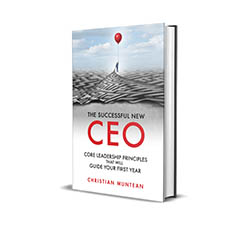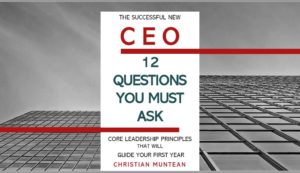Avoid These 5 Mistakes That Sabotage a Leadership Succession

Avoid These 5 Mistakes That Sabotage a Leadership Succession.
Leadership succession is one of the most important questions your company will face. 
Yet, it is rarely given the time and attention it deserves. It’s not that boards or outgoing leaders don’t think or talk about it. They do.
But they talk too little about the wrong topics and they start talking too late.
Research from the University of South Carolina confirms this. They studied Fortune 200 board directors, who sat on a combined number of over 100 boards. These directors were asked about their experiences with and around executive succession.
Of the successions that these directors had participated in, 28% were failures. Another 6% were “too early to tell” but leaning towards failure.
Conclusion: 1 out of 3 CEO successions among these top companies aren’t successful.
These companies don’t reflect the norm. They have higher governance requirements. They attract “A” list board directors, executives, and advisors.
The norm is different for small and medium-sized businesses. These are the ones that make up over 99% of the business landscape.
The majority of these smaller companies will never survive a change in leadership. They aren’t built with that option in mind. Or they underestimate what success requires.
Consider family-owned businesses (which represent 90% of all business enterprises in the US). Only 30% successfully transition from first to second generation of leadership.
Less than one out of three have a successful succession. How do you beat these odds?
Choice Not Chance
The philosopher Seneca observed, “Luck is what happens when preparation meets opportunity.”
The numbers above don’t reflect the “odds” of a successful succession. This isn’t a game of chance. Far from it.
The numbers reflect the presence or absence of appropriate preparation.
Successful successions don’t make the following mistakes:
Mistake #1 – Ignoring personal resistance
Many leaders equate succession with their mortality. They’ve often anchored their identity and self-worth in their work role. Life after their role appears like a form of death.
Boards, partners, or leadership teams, who should be thinking about the succession, face similar problems. They may also feel uncomfortable imagining “life after dear leader”. Additionally, bringing up the topic can feel like a threat or confrontation.
Succession represents change. Change can trigger discomfort or fear. Even more so when the change (and the change process) is unknown or unfamiliar.
Many organizations have built reactive decision-making cultures. They respond to pushes. They don’t actively pull themselves forward. They wait to be pushed into thinking about succession planning.
Mistake #2 – Not having a clear, long-term strategic vision
Knowing where you want to go is critical for identifying the leader best suited to get you there.
Also, a lack of a strategic vision usually indicates deeper problems: An underperforming board or leadership team. An incoming successor is often unable to overcome this inertia.
Mistake #3 – Not seeing succession as a strategic question
Many leaders relate to succession as simply an event or transaction.
Who you choose and how you choose them has an impact. Often this impact occurs in unanticipated ways: Succession changes who stays in the company and who leaves. It impacts relationships within the community. It impacts relationships with customers.
Any decision that has a holistic impact on your organization is a strategic decision. Whether it is related to that way or not.
Mistake #4 – Not knowing how to decide “who?”
“Who” is easier to answer when you have a clear vision for the future. I touched on this in Mistake #2.
But there is more to deciding “who” than having a vision. More common “who” mistakes include:
- Relying on formulas: Search committees or recruiters may rely too heavily on formulas or “off-the-shelf” decision-making tools. There is no equation or software program that can reliably identify the right person. You need to know who your organization wants and needs. That’s specific to your organization. If you need help with that, here is a free template that will help.
- Thinking about the person instead of the position: Many searches start and end with someone who was top of mind or conveniently nearby. The role is then adapted to fit what that person can do or is willing to do. This often doesn’t work. It’s better to define what you are looking for and then find the person who fits that description.
- Not recognizing or resisting bias: Leaders and search committees tend to select someone who is “like me” or “like us”. This often leads to organizations not having enough diversity of thought or experience.
Mistake #5 – Not recognizing that how is as important as who. Successions don’t only fail because of choosing the wrong leader. They can fail because the organization rejects the incoming leader. This can happen when key stakeholders don’t have buy-in on the succession process.
Additionally, succession efforts fail by being too long and drawn out. Or they may be so ambiguous that candidates get frustrated or lose hope. Either way, ideal candidates may leave to pursue opportunities elsewhere.
Last, they fail because of poor administration. For example, not documenting decisions along the way. Or not updating plans. Or not providing enough detail to navigate an actual succession experience.
An appropriate amount of transparency will usually include these elements:
- Communicate who will be involved in the decision-making process
- Describe the key elements of the process
- Define timelines, include what is known and what isn’t
- Reiterate organizational priorities and how succession will serve them
- Whenever appropriate and possible, include stakeholder input into the process
- Provide updates along the way
Avoid these mistakes and you’ll “beat the odds” and have a successful succession process.
Take good care,
Christian
In the podcast Thought Leaders Driving Returns (TLDR), I’m interviewed by host Hunter Guthrie about how important mindset is in leadership and about effecting cultural change in the face of transition. LISTEN HERE.
Are you interested in learning more about becoming a successful CEO? If so, get a free copy of my book The Successful New CEO. Not a new CEO? I’ve been told by “old hands” that they felt any CEO should read this. So, click here to get your copy today.
by “old hands” that they felt any CEO should read this. So, click here to get your copy today.
Let’s connect.
I’m passionate about helping leaders to create workplaces they love going to and increasing the value of the services they offer. My results-oriented approach is tailored to each client’s specific situation and needs. As a leadership coach, I have developed a wealth of resources to help you and your team grow and become stronger.
Weekly Newsletter – sign up to receive my weekly articles addressing critical leadership challenges and issues.
The Leadership Coach Podcast – In my podcast, we explore effective, high-impact, and enjoyable leadership. Subscribe.
Resources – Visit my website’s Resources page for e-books, webinars, training, and leadership coaching opportunities for you and your team.
There are 𝟭𝟮 𝗰𝗿𝗶𝘁𝗶𝗰𝗮𝗹 𝗾𝘂𝗲𝘀𝘁𝗶𝗼𝗻𝘀 to ask before accepting a new CEO position. Do you know what they are? Instantly download my free e-book here.
Find the value of your company with my free assessment tool: The Value Builder System
The Value Builder System™ is a 13-minute online questionnaire that evaluates your business on the eight factors that contribute more to its attractiveness and value. These factors are scored on a scale of 1-100. Businesses that score over 80 are likely to command 70%-100% higher value than others.
Opportunities
Free Resource: How To Accomplish More Without Doing More is a workbook I created to walk leaders through a process of helping you own your calendar, liberate your time, and still get more done. Download it for free!
Executive and Leadership Coaching: Do you feel overwhelmed? Are you not getting the results you expect from the effort you are putting in? Do you find yourself facing similar challenges time and time again? Would you like to change specific ways of relating or reacting? If you would like to experience predictable, measurable growth Contact me.
Profitable Exit Strategy Workshop: Are you a business owner or partner? Over 55? Starting to think about exiting your business or active management in the next 3-5 years?
- Curious about what your business might be worth?
- Would you like to discover the specific steps you need to take to increase its value and become highly attractive to a buyer?
- Are you planning on handing it over to family or employees and you want to ensure long-term success?
If so, contact me now
Categories
Get Christian’s Newest Book: Train to Lead

Download my free 10-page eBook:
How To Accomplish More Without Doing More:
Eight Proven Strategies To Change Your Life
Discover how to save eight hours during your workweek-even if you're too busy to even think about it. The resource every maxed out executive needs.

